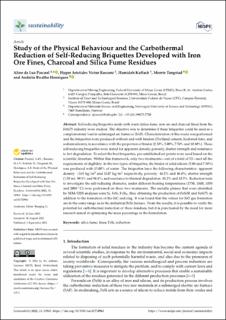| dc.contributor.author | da Luz Pascoal, Aline | |
| dc.contributor.author | Aristides Victor Rossoni, Hygor | |
| dc.contributor.author | Kaffash, Hamideh | |
| dc.contributor.author | Tangstad, Merete | |
| dc.contributor.author | Bicalho Henriques, Andréia | |
| dc.date.accessioned | 2023-03-03T07:42:10Z | |
| dc.date.available | 2023-03-03T07:42:10Z | |
| dc.date.created | 2022-11-09T15:32:02Z | |
| dc.date.issued | 2022 | |
| dc.identifier.issn | 2071-1050 | |
| dc.identifier.uri | https://hdl.handle.net/11250/3055584 | |
| dc.description.abstract | Self-reducing briquettes made with waste (silica fume, iron ore and charcoal fines) from the FeSi75 industry were studied. The objective was to determine if these briquettes could be used as a complementary load in submerged arc furnaces (SAF). Characterization of this waste was performed and the briquettes were produced without and with binders (Portland cement, hydrated lime, and sodium silicate), in accordance with the proportion of binder (2.50%; 5.00%; 7.50% and 10.00%). These self-reducing briquettes were tested for apparent density, porosity, shatter strength and resistance to hot degradation. To select the best briquettes, pre-established set points were used based on the scientific literature. Within this framework, only two treatments—out of a total of 52—met all the requirements of eligibility. In the two types of briquettes, the binder of solid silicate (5.00 and 7.50%) was produced with 15.00% of water. The briquettes have the following characteristics: apparent density: 1165 kg/m3 and 1247 kg/m3 respectively, porosity: 46.2% and 46.0%; shatter strength (1.50 m): 99.3% and 98.8%; and resistance to thermal degradation: 81.2% and 82.5%. Reduction tests to investigate the self-reducing character, under different heating temperatures (1750, 1800, 1850 and 2000 °C) were performed on these two treatments. The metallic phases that were identified by SEM/EDS analyses were Si, FeSi, FeSi2, thus obtaining the production of FeSi50 and FeSi75, in addition to the formation of the SiC and slag. It was found that the values for SiO gas formation are in the same range as in the industrial FeSi furnace. From the results, it is possible to verify the potential for carbothermal reduction of these residues, but it is punctuated by the need for more research aimed at optimizing the mass percentage in the formulation. | en_US |
| dc.description.abstract | Study of the Physical Behaviour and the Carbothermal Reduction of Self-Reducing Briquettes Developed with Iron Ore Fines, Charcoal and Silica Fume Residues | en_US |
| dc.language.iso | eng | en_US |
| dc.publisher | MDPI | en_US |
| dc.rights | Navngivelse 4.0 Internasjonal | * |
| dc.rights.uri | http://creativecommons.org/licenses/by/4.0/deed.no | * |
| dc.title | Study of the Physical Behaviour and the Carbothermal Reduction of Self-Reducing Briquettes Developed with Iron Ore Fines, Charcoal and Silica Fume Residues | en_US |
| dc.title.alternative | Study of the Physical Behaviour and the Carbothermal Reduction of Self-Reducing Briquettes Developed with Iron Ore Fines, Charcoal and Silica Fume Residues | en_US |
| dc.type | Peer reviewed | en_US |
| dc.type | Journal article | en_US |
| dc.description.version | publishedVersion | en_US |
| dc.subject.nsi | VDP::Materialteknologi: 520 | en_US |
| dc.subject.nsi | VDP::Materials science and engineering: 520 | en_US |
| dc.source.volume | 14 | en_US |
| dc.source.journal | Sustainability | en_US |
| dc.source.issue | 17 | en_US |
| dc.identifier.doi | 10.3390/su141710963 | |
| dc.identifier.cristin | 2071353 | |
| dc.relation.project | Norges forskningsråd: 237738 | en_US |
| cristin.ispublished | true | |
| cristin.fulltext | original | |
| cristin.qualitycode | 1 | |

